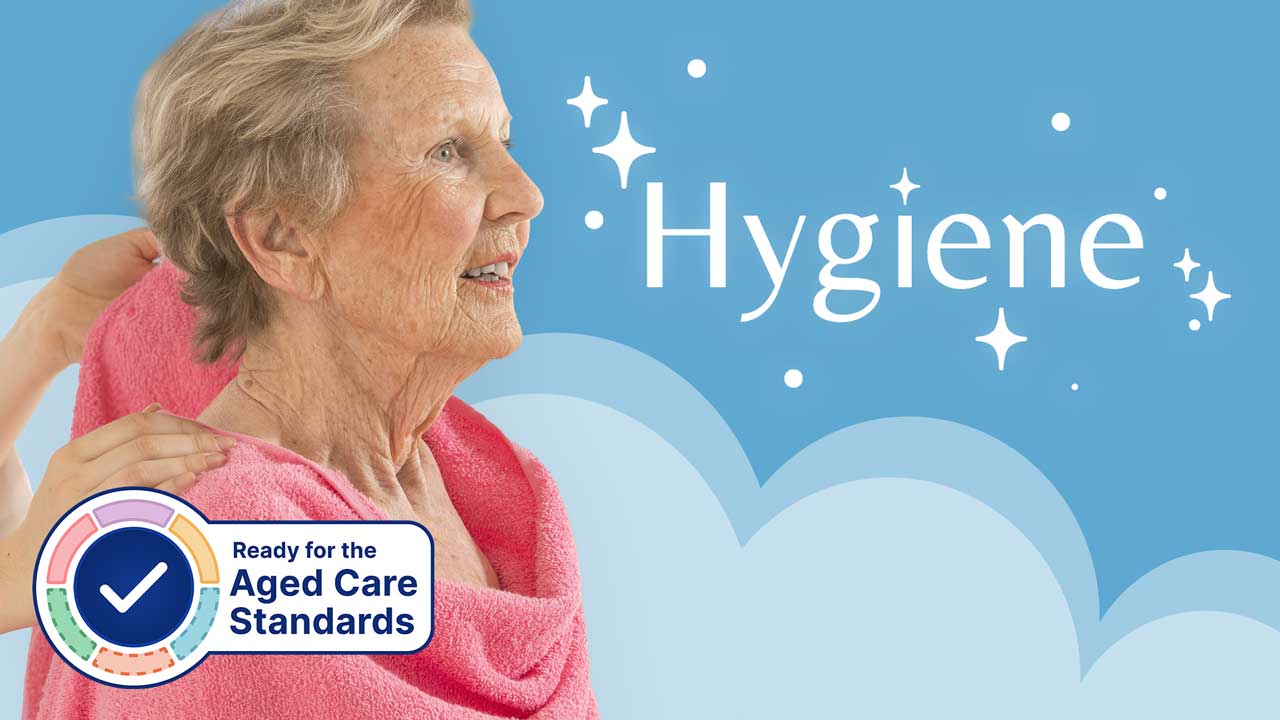Showering and bathing is a personal experience, however, many in your care will need help with this daily-living task.
Personal care and hygiene are different for every person. Some people may prefer baths, while others may want to shower twice a day. Providing clients with the opportunity and support to continue this routine is an essential part of person-centred care.
Showering and bathing not only keep your client feeling fresh and clean, but it is also essential to their health and wellbeing, offers an opportunity to encourage independence and skill use, and can be a good opportunity to assess the person’s skin integrity for wounds, pressure areas or rashes.
The following article offers instructions on showering, bed-bathing and perineal hygiene, which should be used as a guide and in tandem with your organisation’s policies and procedures.
Showering and Bed-Bathing Under the Strengthened Aged Care Quality Standards
Standard 3: Care and Services - Outcome 3.2: Delivery of care and services under the strengthened Aged Care Quality Standards (Action 3.2.2) requires care and services to be delivered in a way that promotes quality of life, reablement and maintenance of function. This includes the provision of personal care (ACQSC 2024).
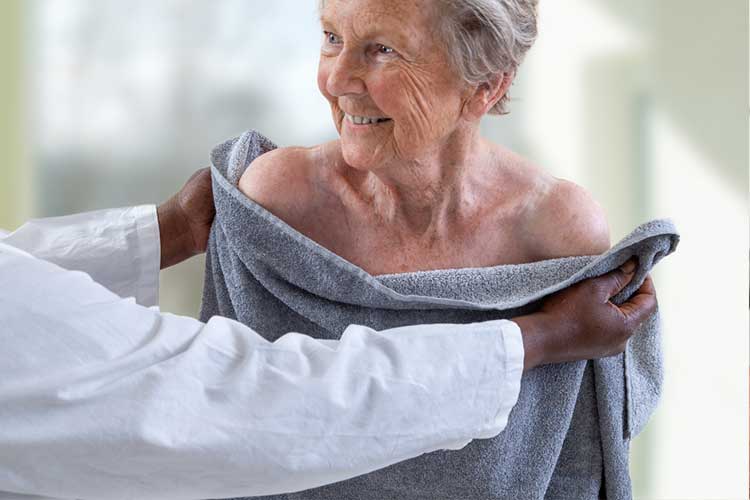
Showering
Equipment:
- Soap (bar or liquid)
- Tear-free sensitive shampoo
- Unscented body lotion for dry skin
- Handrails and a non-slip shower mat
- A shower chair, bench or commode
- 3 washcloths or bath sponges (1 for face, 1 for back and front of the body, 1 for perineal area)
- 2 to 3 towels (minimum) and extra hand towels
- Removable shower head with hose
- Gloves and other PPE (optional but recommended)
(Egan 2021; NT Contributor 2019; Healthwise Staff 2023; Ruth 2012)
Preparation:
- Always begin by consulting the client’s care plan. This should hold important information like pain management requirements or considerations, wound care needs, topical medication administration times, preferred shower routine, communication factors, etc.
- Communicate with the client that you are there to help them wash. It’s essential that you obtain the person’s consent before beginning.
- Ensure the bathroom is warm enough and well-lit.
- Ensure the bathroom floor is clear of clutter such as clothes, linen or towels.
- Have all the equipment laid out beforehand and within reach.
- Apply gloves or PPE as required.
- Set the water temperature to a hot, but safe temperature (generally between 37 and 47°C).
- Test the water temperature with your hand/wrist - never make a client enter a shower or bath without first testing the water.
- Consider your client’s mobility limitations and any mobility aids or hoist transfers (which may require an additional staff member). If they are able to walk freely, guide your client to the toilet before entering the shower. From here they can undress with more privacy and can perform toilet duty beforehand, if necessary. Clients may require assistance undressing and removing items such as jewellery, watches and hearing aids.
- Ensure any brakes and footrests on any shower chairs are down and secure. Consider warming the chair with water or a towel before having the client sit down.
(Egan 2021; Healthwise Staff 2023; Ruth 2012)
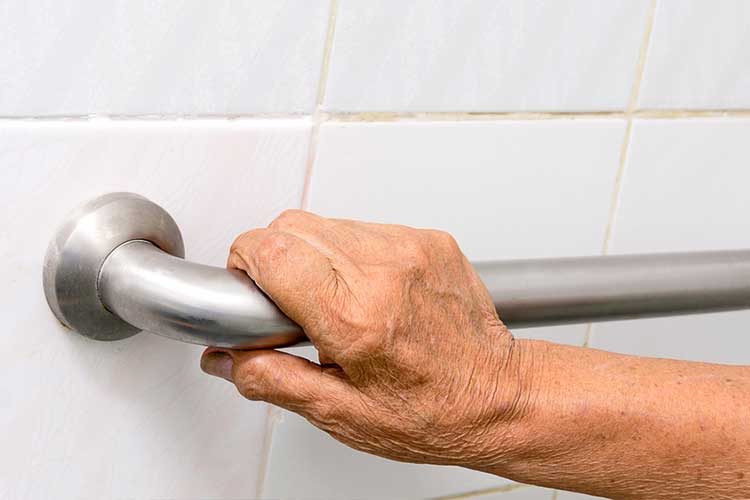
Process
- Note that your client may need only a little help to shower. It's important to let them do as much of the bathing as possible to promote independence and self-esteem.
- Communicate as you move through each step of the showering process with a relaxed and cheery attitude.
- Begin washing the face first with water only, or very mild face-washing soap.
- Allow the client to cover their eyes with the face-cloth while you wash their hair. Encourage them to tip their head back as much as possible, and work quickly (providing a scalp massage as you clean their head and hair is generally appreciated.)
- Cover the face-cloth with soap and have your client wash as much of their body as they are able to.
- Have the client hold the hand-held shower head if they are able to.
- With the second washcloth, soap and clean the client’s back and sections they cannot reach. Remember to communicate with your client, asking whether to scrub harder or gentler.
- Work downwards from their back, then underarms, arms, legs and feet.
- Completely rinse off all soap.
- Wipe dry handrails and your client’s hands and ask the client to stand (only if they are able to).
- With the third washcloth, clean your client’s genital area first, moving from the front to the back.
- Move on to the buttocks and anus area last. Rinse completely.
- Have them sit again and turn off the water.
- Place one towel around your client’s shoulders and another on their front and lap.
- Massage your client through the towel, drying as much of their body and hair as possible. Pay special attention to any skin folds (e.g. groin, under the breasts, between toes) or rash areas. It is essential that you dry the skin as much as possible to avoid potential skin breakdown or fungal and bacterial growth.
- Apply skin lotion to uncovered sections at a time, ensuring your client is not cold. During this process, take the opportunity to check for any skin breakdown or wounds. Apply any additional prescribed skin medications at this time.
- Dry handrails and help your client to stand if they are able to.
- Ensure the client is completely dried and assist them out of the shower.
- Assist your client with dressing and any additional personal care routines such as applying makeup or shaving.
- Once your client is done, ensure the bathroom is clean and left in a safe state. Dispose of any soiled items.
- Document.
(Egan 2021; Healthwise Staff 2023; Ruth 2012)
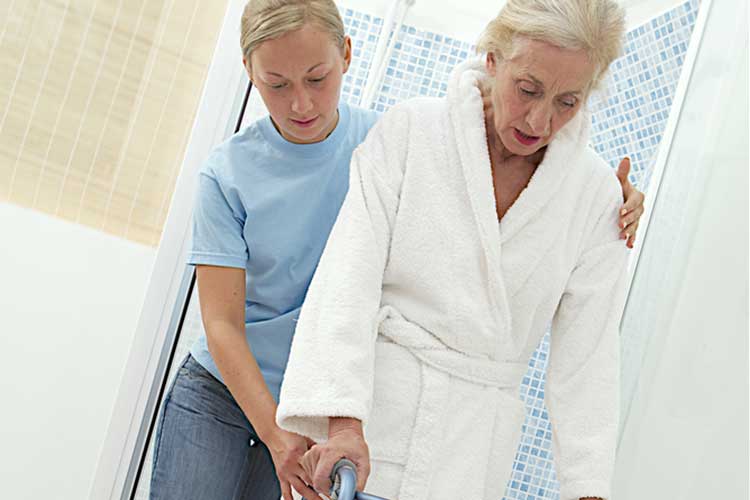
Bed-Bathing
Additional Bed-Bathing Equipment
- Waterproof sheet protector or a change of linen
- Basin and water containers
- No-rinse or dry shampoo
- Additionally, a second person may be required for some bed-bathing steps.
(Egan 2021)
Additional Bed-Bathing Preparation
- Check the client’s care plan to ensure bed bathing is indicated and appropriate.
- Adjust the bed to a safe height (waist level of the tallest care person).
- Place a waterproof sheet protector (if available) or towels under the client to keep any bedding from getting wet.
- Allow the client to undress as much of their bedclothes as they can.
- Assist in rolling the client to remove remaining bedclothes (two people may be needed). Leave a single sheet as a covering for the client’s privacy and comfort.
(Egan 2021)
Process
- Your client should be lying on their back with legs slightly apart and arms by their sides.
- To ensure your client’s privacy and warmth, move in sections and only uncover parts of the body at a time.
- Wash your client’s face, neck and armpits with a facecloth. Allow them to do as much as they are able to themself.
- Work down from the shoulders, bathing the client with a gentle massaging motion through the washcloths.
- Take particular care to wash in skin creases and to check for any skin breakdown, rashes or sores.
- Dry in sections with towels, once again taking particular care their skin is dry.
- With a second person, roll the client onto their side if the client is unable to assist.
- Clean down from the client’s shoulders and back.
- Use a third washcloth to clean the client’s genital, perineal and, finally, anal area.
- Dry these sections with towels while the client is on their side.
- Carefully roll the client onto their back again.
- With fresh water, wash the client’s hair with a no-rinse or dry shampoo.
- Assist your client with dressing and any additional personal care routines such as applying makeup, shaving and dental care.
- Change the bed linen if required.
- Apply body lotion to arms, legs, feet and any other dry areas of the skin. Apply any additional prescribed skin medications at this time.
- Dispose of any soiled items.
- Document.
(Egan 2021; MedlinePlus 2023)
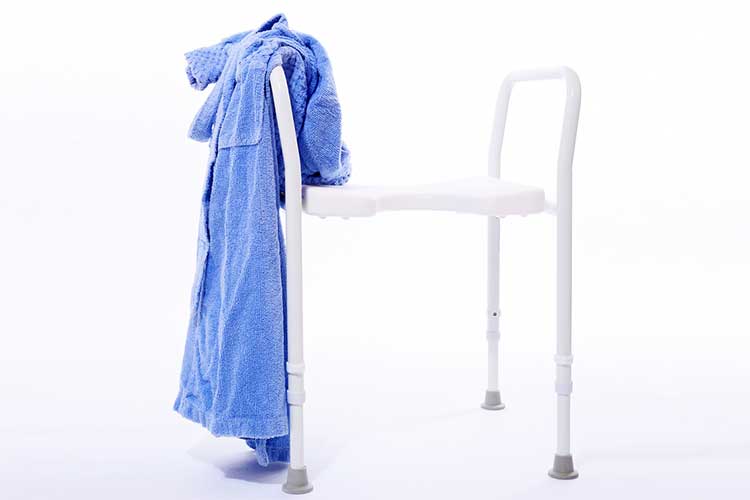
Additional Considerations
- Clients will often respond more positively to being assisted by a carer of the same gender.
- Document and report any changes you notice in your client’s physical, cognitive or emotional condition.
- Reduce the risk of falls and slips by mopping up any excess water immediately.
- Your client has the right to refuse a shower and their choice should be respected. If the client has a cognitive impairment, advice should be sought from a supervisor and your organisation’s policies on how to proceed.
- Build a relationship with your client and try and stick to a hygiene routine.
- Try to remain relaxed and professional throughout the showering and bathing process. If you feel uncomfortable, this can make the client more self-conscious and it could become a negative experience.
(Aged Care Insite 2010; HelloCare Editorial Team 2018)
Test Your Knowledge
Question 1 of 3
Which part of the body should be washed last?
Topics
Further your knowledge
References
- Aged Care Quality and Safety Commission 2024, Standard 3: Care and Services, Australian Government, viewed 6 May 2024, https://www.health.gov.au/resources/publications/strengthened-aged-care-quality-standards-august-2025?language=en
- Egan, C 2021, ‘How to Give an Elderly Person a Bed Bath’, HelloCare, 25 May, viewed 6 May 2024, https://hellocaremail.com.au/best-way-give-elderly-person-bed-bath/
- Healthwise Staff 2023, Caregiving: How to Help With a Shower, University of Michigan, viewed 6 May 2024, https://www.uofmhealth.org/health-library/abq1244
- HelloCare Editorial Team 2018, ‘5 Dementia and Bathing Tips for Carers’, HelloCare, 6 December, viewed 6 May 2024, https://hellocare.com.au/5-dementia-and-bathing-tips-for-carers/
- MedlinePlus 2023, Bathing a Patient in Bed, U.S. Department of Health and Human Services, viewed 6 May 2024, https://medlineplus.gov/ency/patientinstructions/000427.htm
- NT Contributor 2019, ‘The Underlying Principles and Procedure for Bed Bathing Patients’, Nursing Times, 25 April, viewed 6 May 2024, https://www.nursingtimes.net/roles/hospital-nurses/the-underlying-principles-and-procedure-for-bed-bathing-patients-25-04-2019/
- Ruth 2012, ‘Showering an Elderly Person - a Step by Step Guide’, Sharing the Sunset blog, 21 January, viewed 6 May 2024, http://sharingthesunset.blogspot.com/2012/01/showering-elderly-person-step-by-step.html#.XXb6z5MzZTY
 New
New 